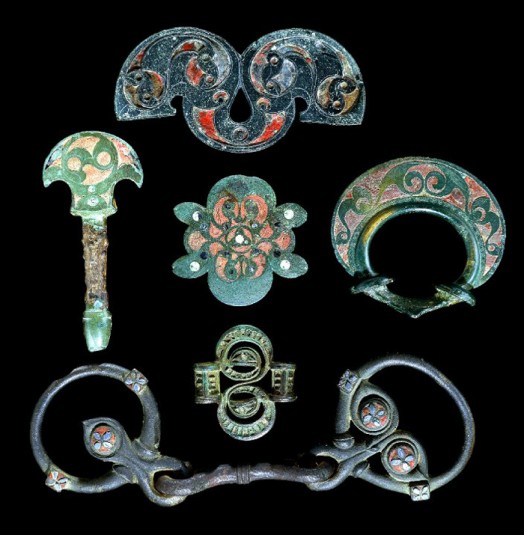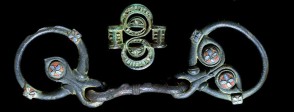
Horses and chariots
These objects are parts of the harness used for horses and chariots in the Iron Age. Horses were expensive to keep so vehicles drawn by them could only have been used by people in the social elite. Vehicles might have two or four wheels, but those with two should not be regarded automatically as war chariots; they could be used in battle - Julius Caesar describes Gallic warriors throwing javelins from chariots and then dismounting to fight on foot - but were probably also used in peace time.
While the use of horse-drawn vehicles was in itself an expression of wealth and status, their beautifully decorated metal parts also contributed to the impression they made. The gleaming bronze of the fitments and bright colours of their glass inlays would have stood out against the dull tones of everyday life.
A chariot burial of a woman
In 2001 an Iron Age grave dating from about 300 BC was discovered in the village of Wetwang in East Yorkshire. It was found to contain the body of a woman aged about 35-45 when she died. The grave had also contained a two-wheeled chariot, which had rotted away leaving just its metal parts and fine bronze fittings, some of them inlaid with coral.
The woman was probably brought to the grave on the chariot and then placed on top of a blanket which left an impression in the soil underneath her. Joints of pork, perhaps meals for the afterlife, were placed on top of her upper body and prized possessions of a mirror and a brooch decorated with coral were put in a bag by her legs. The chariot was dismantled and placed on top of and around the body. A mound of earth was built over the grave. A similar style of burial is known in a region of northern France and it is thought that there were contacts between the two areas. More far reaching contacts are suggested by the coral inlay, which came from the Mediterranean or even the Red Sea or Gulf.
Burial practices in East Yorkshire were unusual in the Iron Age. The dead were buried in cemeteries and it is the only part of Britain in which chariot-burials have been found. Even so, only seven out of seven hundred Middle Iron Age burials excavated there contained a chariot. People buried with chariots were obviously special, but we do not know whether they were leaders or important for some other reason. A male burial may contain a sword and thus suggest that the dead person was a famous warrior, but the presence of a sword may simply be an indicator of gender. Similarly, female burials often contain mirrors and this practice is reflected at Wetwang. However, the Wetwang burial clearly indicates that women could achieve high status in Iron Age society, as in the case of Queen Boudica some 350 years later.
Reconstructing the chariot
The BBC filmed the excavation of the Wetwang burial and funded a reconstruction of the chariot to see how it would work and what it looked like. It drew on other chariot burials and finds of harness fittings, the images of chariots from coins, as well as the evidence from Wetwang. Coins from the time show what these chariots looked like, with a distinctive curved ‘m’ on each side of the box where the driver sat or stood. These were used as suspension hoops to hang the box from so the ride was smoother.
More information
Explanation of the different pieces of harness
http://www.britishmuseum.org/explore/highlights/highlight_objects/pe_prb/h/horse_harness_fittings.aspx
Explanation of how terrets were used
http://www.britishmuseum.org/explore/highlights/highlight_objects/pe_prb/t/polden_hill_hoard_terrets.aspx
Wetwang burial
British Museum online tour of the Wetwang burial and chariot reconstruction.
http://www.britishmuseum.org/explore/online_tours/britain/the_wetwang_chariot_burial/the_wetwang_chariot_burial.aspx
The excavation
The story of the excavation from the BBC History website.
http://www.bbc.co.uk/history/trail/archaeology/wetwang/wetwang_story_of_dig_01.shtml
Reconstruction of the chariot
An explanation of the reconstruction of the chariot from the BBC History website.
http://www.bbc.co.uk/history/trail/archaeology/wetwang/wetwang_chariot_queen_01.shtml
More information
-
Explanation of the different pieces of harness
Source: britishmuseum.org
-
Explanation of how terrets were used
Source: britishmuseum.org
-
Wetwang burial
British Museum online tour of the Wetwang burial and chariot reconstruction.
Source: britishmuseum.org
-
The excavation
The story of the excavation from the BBC History website.
Source: bbc.co.uk
-
Reconstruction of the chariot
An explanation of the reconstruction of the chariot from the BBC History website.
Source: bbc.co.uk


